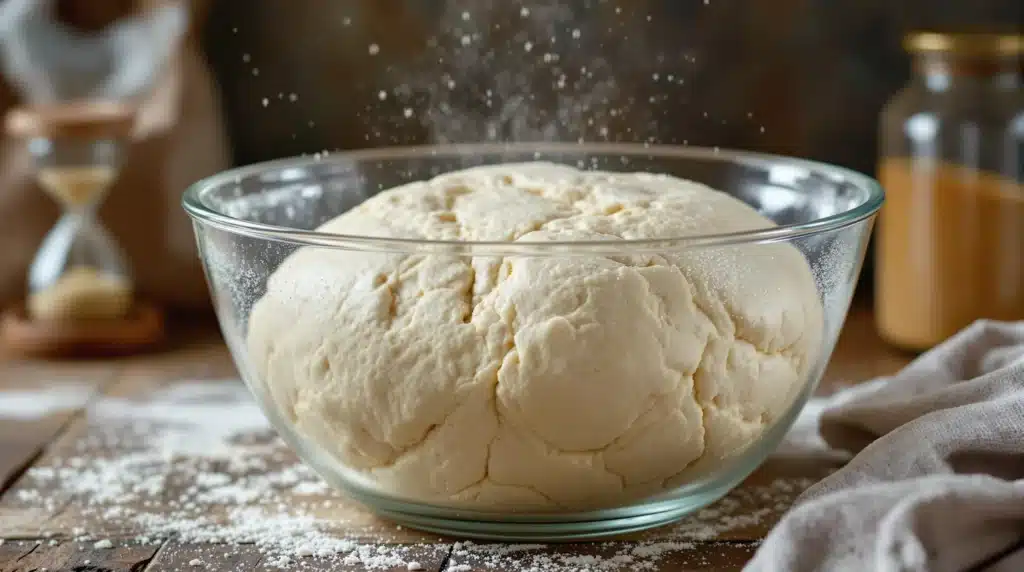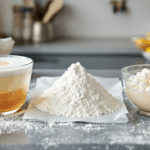What truly elevates a simple loaf of bread into the realm of “artisan”? Often, it’s not just the crusty exterior or the open crumb; it’s the flavor. A truly exceptional loaf offers a depth and complexity that goes far beyond the simple taste of baked flour. It might have nutty undertones, a subtle sweetness, a pleasant tang, or a rich, wheaty aroma that fills the kitchen. This captivating character isn’t just happenstance; it’s largely born from the intricate, somewhat magical process of fermentation.
For many aspiring bakers, fermentation is primarily associated with making dough rise – the function of yeast producing carbon dioxide. While leavening is crucial, focusing solely on the rise overlooks fermentation’s profound role as the engine of flavor development. Rushing this stage, perhaps by using too much yeast or proofing in an overly warm environment for speed, might yield a tall loaf, but often one that lacks character. Understanding how fermentation works its magic allows bakers to move beyond just creating volume and start intentionally cultivating deep, complex, and truly memorable bread flavor.
Beyond the Bubbles: What Is Fermentation in Bread?
At its core, fermentation in bread making is a biological process driven by microscopic organisms – primarily yeasts and, especially in sourdough, bacteria. These microbes metabolize the carbohydrates (sugars and starches) present in the flour, primarily in an anaerobic environment (without much oxygen). This metabolic activity produces various byproducts, some of which cause the dough to rise, and many others that create the building blocks of flavor and aroma.
Let’s meet the key players involved:
- Yeast: Whether it’s the commercially produced Saccharomyces cerevisiae (in packets or blocks) or the diverse wild yeasts captured in a sourdough starter, yeast’s main job that we readily observe is producing Carbon Dioxide (CO2) gas. These gas bubbles get trapped by the dough’s gluten network, causing it to rise (leavening). However, yeast also produces Ethanol (an alcohol) and smaller quantities of other volatile compounds (like esters and aldehydes) that contribute significantly to the bread’s aroma and flavor profile.
- Lactic Acid Bacteria (LAB): While present in small amounts even in commercial yeast doughs undergoing long fermentation, LAB are the star players alongside wild yeasts in sourdough starters. These beneficial bacteria primarily produce Lactic Acid (creating a mild, tangy, yogurt-like flavor) and Acetic Acid (providing a sharper, more vinegar-like tang). The balance between these two acids heavily influences the final “sourness” profile of the bread. LAB also contribute some CO2 and other complex flavor compounds.
- Enzymes: These aren’t living organisms but biological catalysts naturally present in the flour (and sometimes added by millers). Two key types are crucial for fermentation:
- Amylase: Breaks down complex starches in the flour into simpler sugars (like maltose and glucose). This is vital because yeast and LAB can primarily consume only these simple sugars as food.
- Protease: Breaks down proteins, including gluten. Moderate protease activity over time can make the dough more extensible (easier to stretch and shape) and potentially release flavor precursors locked within the proteins. Excessive activity can weaken the dough structure.
Fermentation, therefore, is a complex interplay where enzymes prepare the food (sugars) from starch, and then yeasts and bacteria consume this food, producing CO2 for rise, alcohol, acids, and a wide array of other compounds that build flavor and aroma.
The Flavor Factory: How Fermentation Creates Taste & Aroma
So, where does that incredible depth of flavor in well-fermented bread actually come from? It’s a combination of factors generated during this microbial feast:
- Alcohol (Ethanol): Produced abundantly by yeast. While the high heat of baking evaporates most of the liquid alcohol, its presence during fermentation and the trace amounts remaining contribute significantly to the characteristic “yeasty” or “fermented” aroma and a perceived richness in the finished loaf.
- Organic Acids (Lactic & Acetic): These are the primary drivers of the tangy or “sour” flavor in sourdough, produced by LAB. Lactic acid provides a softer, milder tang often associated with yogurt, while acetic acid delivers a sharper, more pungent sourness akin to vinegar. The specific balance achieved depends on the LAB strains present, temperature, and hydration. Even long-fermented commercial yeast doughs can develop trace amounts of acidity, adding subtle complexity.
- Volatile Compounds (Esters, Aldehydes, Ketones, etc.): This is where much of the subtle magic happens. As yeast and bacteria metabolize sugars and interact with other compounds in the dough, they produce hundreds of different volatile organic compounds in small amounts. These contribute nuanced aromas and flavors described as fruity (like apples or bananas), floral, buttery (like diacetyl), nutty, or earthy. Longer, often cooler, fermentation periods allow for a greater diversity and concentration of these desirable compounds to develop.
- Flour Contribution (Enhanced by Enzymes): The flour itself contains flavor precursors. The extended action of enzymes (amylase and protease) during fermentation helps break down components of the grain, making these inherent flour flavors more available and noticeable in the final bread. This is why longer fermentation often results in a more pronounced “wheaty” or “grainy” flavor.
The final, unique flavor profile of any loaf is the result of this intricate symphony – the specific blend of alcohols, acids, and volatile compounds produced by the particular mix of microbes (commercial yeast vs. diverse wild yeasts and LAB), interacting with the specific flour used, all under the influence of the fermentation conditions set by the baker.
Controlling the Magic: Factors Influencing Fermentation & Flavor
The exciting part for bakers is that we aren’t just passive observers; we can actively influence the fermentation process to steer the flavor profile towards our desired outcome. The key levers we can pull are:
- Time (The Great Flavor Developer): This is arguably the most critical factor. Longer fermentation generally equals more flavor. More time simply allows the yeast, bacteria, and enzymes more opportunity to do their work – producing more acids, alcohols, and complex volatile compounds, and breaking down more starches and proteins. Quick breads made with commercial yeast and minimal rising time will inherently have less complex fermentation flavors compared to a sourdough loaf fermented over 24 hours. If you want deeper flavor, slow down the process.
- Temperature (The Orchestra Conductor): Temperature doesn’t just affect the speed of fermentation; it influences which microbes are most active and what byproducts they favor.
- Warmer Temperatures (e.g., 75-85°F / 24-29°C): Yeast activity increases significantly, leading to faster CO2 production and quicker rising. In sourdough, warmer temperatures often favor LAB that produce more lactic acid, resulting in a milder, less sharp tang. If fermentation is too fast due to excessive warmth, flavor complexity can be reduced.
- Cooler Temperatures (e.g., 50-65°F / 10-18°C, or refrigerator temps 38-40°F / 3-4°C): Yeast activity slows down considerably. However, LAB activity (especially acetic acid production) and enzymatic activity continue at a slower pace. This extended time at cooler temperatures allows for the development of more complex volatile flavor compounds and often a sharper, more vinegary tang (acetic acid) in sourdough. This is the principle behind retardation or cold fermentation, deliberately used to enhance flavor.
- Hydration (The Environment): The amount of water in your dough affects microbial mobility and activity. Wetter doughs (higher hydration) can sometimes ferment faster and may influence the type and amount of acids produced by LAB.
- Starter / Pre-ferment Management (The Microbial Team):
- Sourdough Starter Care: How you feed and maintain your sourdough starter (feeding ratio, temperature, flour type) directly impacts the balance of yeast and LAB populations and its overall acidity (pH), which carries through to the final dough’s flavor profile. A stiffer starter often favors acetic acid; a wetter one might favor lactic acid.
- Pre-ferments (Poolish, Biga, Pâte Fermentée): These are portions of flour, water, and a small amount of yeast (commercial or sourdough starter) that are mixed and allowed to ferment for an extended period (often overnight) before being added to the final dough. This “head start” introduces a significant amount of mature fermentation byproducts (acids, alcohols, esters) into the final mix, adding considerable flavor complexity relatively quickly, even if the final dough itself has a shorter fermentation time. (We’ll explore these in detail in a later article).
- Ingredients (The Raw Materials):
- Flour Choice: Whole grain flours (whole wheat, rye, spelt, etc.) contain more bran and germ, which provide more nutrients for microbes and contain more inherent flavor precursors and enzymes. Breads made with whole grains typically have deeper, earthier, nuttier flavors developed during fermentation compared to breads made solely with refined white flour. Rye flour, in particular, contributes unique enzymatic activity and tangy flavor notes.
- Salt: While primarily for taste, salt also plays a crucial role in controlling the rate of yeast fermentation, preventing it from happening too quickly and allowing flavors proper time to develop.
- Enrichments: Ingredients like sugar, milk, eggs, and fat can influence yeast activity (high sugar levels can slow it down) and contribute their own significant flavors to the final product, interacting with the fermentation flavors.
Practical Application: Techniques for Flavorful Bread
Knowing the science is great, but how do you apply it? Here are practical ways to encourage deeper flavor development:
- Embrace Longer Fermentation Times: Don’t rush your bulk fermentation or final proof just to get bread faster. Follow recipe timings, or even extend them slightly if proofing at cooler room temperatures, allowing more time for flavor development. Use the dough’s cues (volume, feel, smell) rather than just the clock.
- Utilize Cold Fermentation (Retarding): This is a powerful technique. Try refrigerating your dough after shaping (final proof) or even during bulk fermentation for 12, 24, 48 hours, or even longer. This extended cold period works wonders for developing complex, nuanced flavors and often improves crust characteristics too.
- Explore Sourdough: If you crave that characteristic tang and intricate flavor profile, cultivating and baking with a sourdough starter is the ultimate journey in fermentation flavor. Learn to manage your starter to influence its sourness.
- Incorporate Pre-ferments: Even when using commercial yeast, adding a pre-ferment (like a simple overnight poolish or biga) to your recipe is a relatively easy way to significantly boost flavor complexity without needing multi-day cold fermentation.
- Experiment with Flour: Don’t just stick to white flour. Try incorporating a percentage (start small, maybe 15-30%) of whole wheat, rye, spelt, or other whole or ancient grains into your favorite recipes to add inherent grain flavor that fermentation will enhance.
Conclusion: Conducting the Flavor Symphony
Fermentation is the soulful heart of artisan bread, the invisible process that transforms humble ingredients into something complex, aromatic, and deeply satisfying. It’s far more than just the mechanism for making dough rise; it’s an active flavor factory where yeasts, bacteria, and enzymes collaborate to create a rich tapestry of tastes and smells.
As a baker, you are the conductor of this microbial orchestra. By understanding how time, temperature, hydration, and ingredients influence the fermentation process, you gain the power to guide the development of flavor. Be patient, allow fermentation the time it needs. Experiment with cooler temperatures or retardation to unlock more complex notes. Consider the profound impact of sourdough or the flavor boost from pre-ferments. Don’t be afraid to explore different flours.
By appreciating and harnessing the magic of fermentation, you move beyond simply baking bread to crafting loaves with character, depth, and a flavor that truly tells a story.







